Related Research Articles

The Colwich rail crash occurred on the evening of Friday 19 September 1986 at Colwich Junction, Staffordshire, England. It was significant in that it was a high speed collision between two packed express trains. One driver was killed, but no passengers died because of the great strength of the rolling stock involved, which included examples of Mk1, Mk2 and Mk3 coaches.
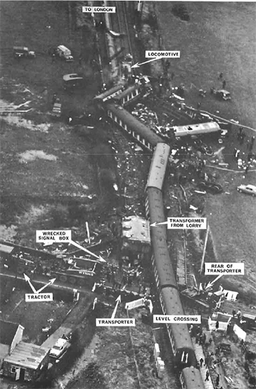
On 6 January 1968, a low-loader transporter carrying a 120-ton electrical transformer was struck by a British Rail express train on a recently installed automatic level crossing at Hixon, Staffordshire, England.
The Norton Fitzwarren rail crash occurred on 4 November 1940 between Taunton and Norton Fitzwarren in the English county of Somerset, when the driver of a train misunderstood the signalling and track layout, causing him to drive the train through a set of points and off the rails at approximately 40mph. 27 people were killed. The locomotive involved was GWR King Class GWR 6028 King Class King George VI which was subsequently repaired and returned to service. A previous significant accident occurred here on 10 November 1890 and the Taunton train fire of 1978 was also within 2 miles.

Luton railway station is located in the town centre of Luton, Bedfordshire, England. The station is about three minutes' walk from The Mall Shopping Centre. It is situated on the Midland Main Line and is operated by Thameslink.

Stafford railway station is a major interchange railway station in Stafford, Staffordshire, England, and is the second busiest railway station in Staffordshire, after Stoke-on-Trent. The station serves the county town, as well as surrounding villages. The station lies on the junction of the Trent Valley line, the Birmingham Loop/Rugby–Birmingham–Stafford line, and the West Coast Main Line.

The Harrow and Wealdstone rail crash was a three-train collision at Harrow and Wealdstone station in Wealdstone, Middlesex during the morning rush hour of 8 October 1952. The crash resulted in 112 deaths and 340 injuries, 88 of these being detained in hospital. It remains the worst peacetime rail crash in British history and the second deadliest overall after the Quintinshill rail disaster of 1915.

Over the latter years of the 19th and early years of the 20th centuries, Penistone in Yorkshire gained a name as an accident black-spot on Britain's railway network; indeed, it could be said to hold the title of the worst accident black-spot in the country. The main line through the town was the Woodhead route of the Manchester, Sheffield and Lincolnshire Railway between Sheffield Victoria and Manchester, London Road. The line was heavily graded with a summit some 400 yards inside the eastern portal of the Woodhead tunnel.

The 1892 Thirsk rail crash happened at Manor House signal box on 2 November 1892, on the North Eastern Railway about 3 miles (4.8 km) north of Thirsk railway station in the North Riding of Yorkshire, England.

The Gare de Lyon rail accident occurred on 27 June 1988, when an SNCF commuter train headed inbound to Paris's Gare de Lyon terminal crashed into a stationary outbound train, killing 56 and injuring 60, resulting in the third deadliest rail disaster in peacetime France.
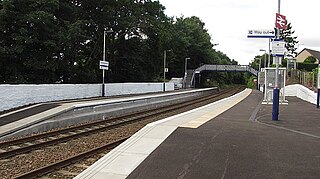
Invergowrie railway station is a railway station which serves the village of Invergowrie, west of the city of Dundee, Scotland on the north bank of the Firth of Tay. It is the only intermediate station between Dundee and Perth, on the Glasgow to Dundee line, approximately 4 miles from Dundee, and just over 17 miles from Perth. ScotRail, who manage the station, provide all the services.
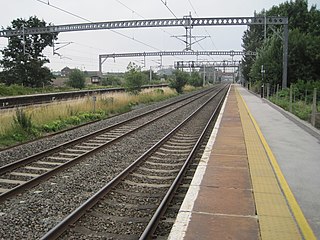
Polesworth railway station serves the village of Polesworth in Warwickshire, England. It is situated on the Trent Valley section of the West Coast Main Line.
Two rail accidents have occurred near Castlecary, Scotland. One of these was in 1937 and one in 1968. Both events involved rear-end collisions, and caused the deaths of 35 and 2 people respectively.
The Darlington rail accident occurred on the evening of 27 June 1928 when a parcels train and an excursion train collided head on at Darlington Bank Top railway station in County Durham, England. The accident was caused by the parcels train driver passing a signal at danger, due to misunderstanding the signalling layout in an unfamiliar part of the station. This accident resulted in the deaths of 25 people and the serious injury of 45 people.

The Spa Road Junction rail crash was an accident on the British railway system which occurred during the peak evening rush hour of 8 January 1999 at Spa Road Junction in Bermondsey, in South East London.
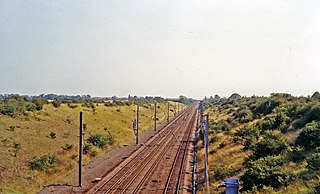
The Abbots Ripton rail disaster occurred on 21 January 1876 at Abbots Ripton, then in the county of Huntingdonshire, England, on the Great Northern Railway main line, previously thought to be exemplary for railway safety. In the accident, the Special Scotch Express train from Edinburgh to London was involved in a collision, during a blizzard, with a coal train. An express travelling in the other direction then ran into the wreckage. The initial accident was caused by:

The 1984 Eccles rail crash occurred on 4 December 1984 at Eccles, Greater Manchester, when an express passenger train collided at speed with the rear of a freight train of oil tankers. The driver of the express and two passengers were killed, and 68 people were injured. The cause of the accident was determined to be that the driver of the express train had passed a signal at danger.
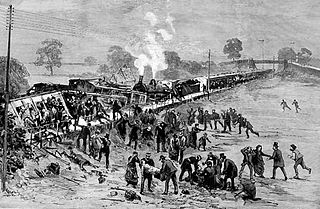

The Knowle and Dorridge rail crash was a fatal rail crash that occurred at Dorridge railway station in the West Midlands, England, on 15 August 1963. Three people died in the crash after a signalman's error routed a small freight train into the path of an express passenger train which slowed but could not stop before colliding with it.
The Slough rail accident happened on 16 June 1900 at Slough railway station on the Great Western Main Line when an express train from London Paddington to Falmouth Docks ran through two sets of signals at danger, and collided with a local train heading for Windsor & Eton Central. Five passengers were killed; 35 were seriously injured, and 90 complained of shock or minor injuries
On 3 February 2003, a Comeng electric multiple unit train rolled away from Broadmeadows station in Melbourne, Australia, before it ran for nearly 17 kilometres (11 mi) out of control without a driver and eventually crashed into another train about to depart Spencer Street station. Train controllers attempted several times to stop or redirect the train, but were limited in their ability to intervene, instead being forced to alter the route of other trains to avert a more serious collision. Eleven people on board the stationary train were injured; authorities did not know until after the crash if any passengers were on board the runaway. An investigation identified driver error as the cause of the accident, but the runaway event prompted significant debate about the role of government authorities and private operators in ensuring safety and reliability on the Melbourne rail network.
References
- ↑ Webb, Jonathan (May 2017). "Focus on Stafford". Today's Railways UK. No. 185. Sheffield: Platform 5. pp. 54–55. ISSN 1475-9713.
- ↑ "Railway accident at Stafford" (PDF). railwaysarchive.co.uk. Health and Safety Executive. 5 January 1994. p. 14. Retrieved 16 April 2017.